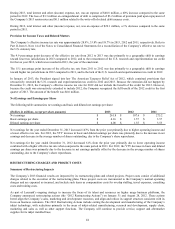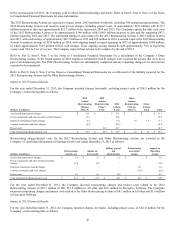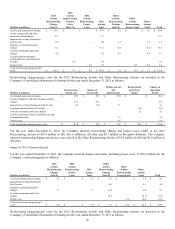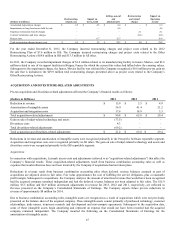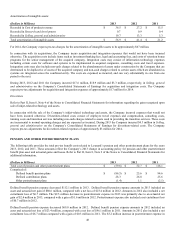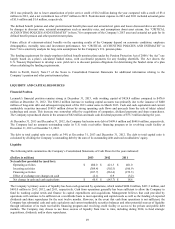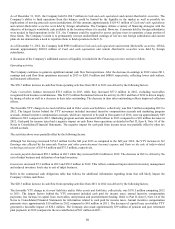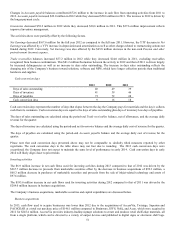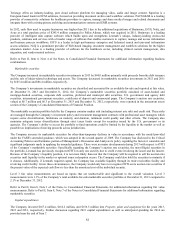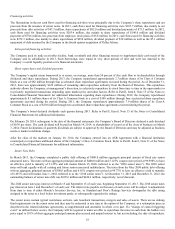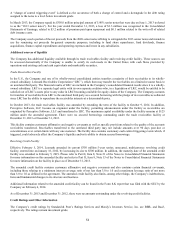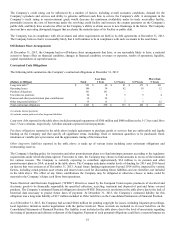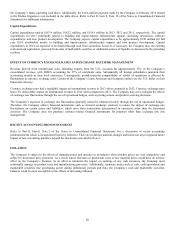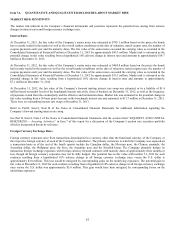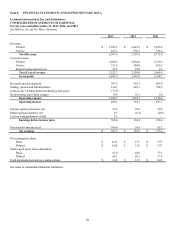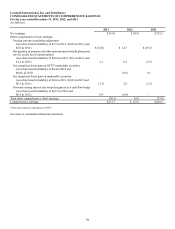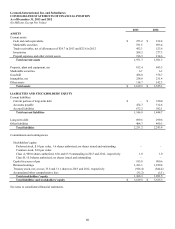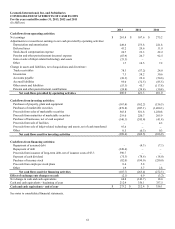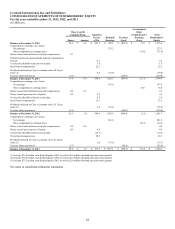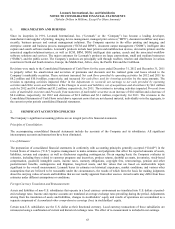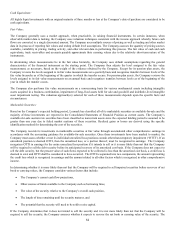Lexmark 2013 Annual Report Download - page 58
Download and view the complete annual report
Please find page 58 of the 2013 Lexmark annual report below. You can navigate through the pages in the report by either clicking on the pages listed below, or by using the keyword search tool below to find specific information within the annual report.
54
A “change of control triggering event” is defined as the occurrence of both a change of control and a downgrade in the debt rating
assigned to the notes to a level below investment grade.
In March 2013, the Company repaid its $350.0 million principal amount of 5.90% senior notes that were due on June 1, 2013 (referred
to as the “2013 senior notes”). For the year ended December 31, 2013, a loss of $3.3 million was recognized in the Consolidated
Statements of Earnings, related to $3.2 million of premium paid upon repayment and $0.1 million related to the write-off of related
debt issuance costs.
The Company used a portion of the net proceeds from the 2020 senior notes offering to extinguish the 2013 senior notes and intends to
use the remaining net proceeds for general corporate purposes, including to fund share repurchases, fund dividends, finance
acquisitions, finance capital expenditures and operating expenses and invest in any subsidiaries.
Additional sources of liquidity
The Company has additional liquidity available through its trade receivables facility and revolving credit facility. These sources can
be accessed domestically if the Company is unable to satisfy its cash needs in the United States with cash flows provided by
operations and existing cash and cash equivalents and marketable securities.
Trade Receivables Facility
In the U.S., the Company and one of its wholly-owned consolidated entities transfers a majority of their receivables to its wholly-
owned subsidiary, Lexmark Receivables Corporation (“LRC”), which then may transfer the receivables on a limited recourse basis to
an unrelated third party. The financial results of LRC are included in the Company’s consolidated financial results since it is a wholly-
owned subsidiary. LRC is a separate legal entity with its own separate creditors who, in a liquidation of LRC, would be entitled to be
satisfied out of LRC’s assets prior to any value in LRC becoming available for equity claims of the Company. The Company accounts
for transfers of receivables from LRC to the unrelated third party as a secured borrowing with the pledge of its receivables as collateral
since LRC has the ability to repurchase the receivables interests at a determinable price.
In October 2013, the trade receivables facility was amended by extending the term of the facility to October 9, 2014. In addition,
Perceptive Software, LLC became an originator under the facility, permitting advancements under the facility as receivables are
originated by Perceptive Software, LLC and transferred to LRC. The maximum capital availability under the facility remains at $125
million under the amended agreement. There were no secured borrowings outstanding under the trade receivables facility at
December 31, 2013 or December 31, 2012.
This facility contains customary affirmative and negative covenants as well as specific provisions related to the quality of the accounts
receivables transferred. Receivables transferred to the unrelated third party may not include amounts over 90 days past due or
concentrations over certain limits with any one customer. The facility also contains customary cash control triggering events which, if
triggered, could adversely affect the Company’s liquidity and/or its ability to obtain secured borrowings.
Revolving Credit Facility
Effective February 5, 2014, Lexmark amended its current $350 million 5-year senior, unsecured, multicurrency revolving credit
facility, entered into on January 18, 2012, by increasing its size to $500 million. In addition, the maturity date of the amended credit
facility was extended to February 5, 2019. Please refer to Part II, Item 8, Note 21 of the Notes to Consolidated Financial Statements
for more information on this amended facility and refer to Part II, Item 8, Note 13 of the Notes to Consolidated Financial Statements
for more information on the facility in place as of December 31, 2013.
The amended credit facility contains customary affirmative and negative covenants and also contains certain financial covenants,
including those relating to a minimum interest coverage ratio of not less than 3.0 to 1.0 and a maximum leverage ratio of not more
than 3.0 to 1.0 as defined in the agreement. The amended credit facility also limits, among other things, the Company’s indebtedness,
liens and fundamental changes to its structure and business.
Additional information related to the amended credit facility can be found in the Form 8-K report that was filed with the SEC by the
Company on February 6, 2014.
As of December 31, 2013 and December 31, 2012, there were no amounts outstanding under the revolving credit facilities.
Credit Ratings and Other Information
The Company’s credit ratings by Standard & Poor’s Ratings Services and Moody’s Investors Service, Inc. are BBB- and Baa3,
respectively. The ratings remain investment grade.
54


